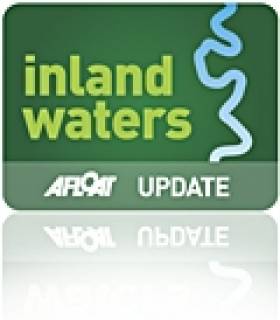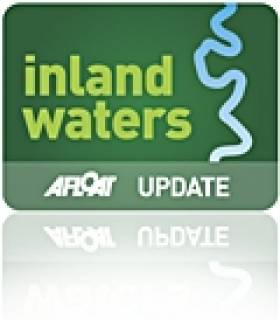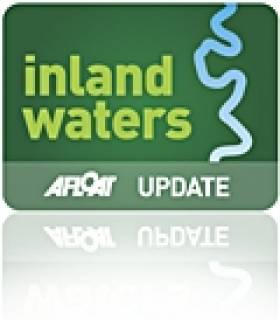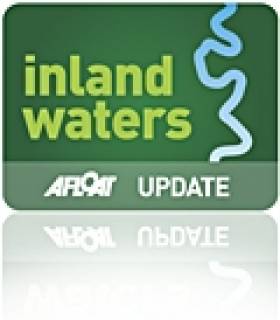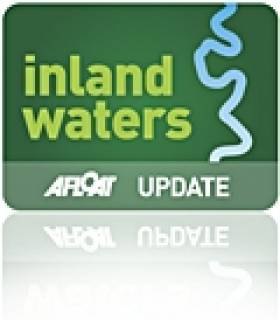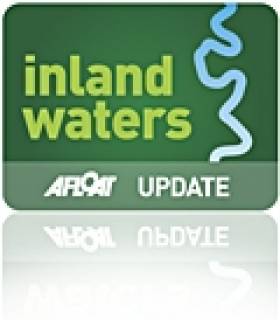Displaying items by tag: inland waterways
#inland – The Rivers Agency has advised that the sluice gates at Toome will be opened from the morning of Tuesday 15th October, to facilitate a testing exercise at the Cutts gates in Coleraine. They will remain open until the morning of Saturday 19th October. Boaters may experience strong flows during this exercise.
For queries please contact:
The Rivers Agency
37 Castleroe Road
Castleroe
Coleraine
BT51 3RL
Tel: 028 7034 2357
Fax: 028 7032 0628
Email: [email protected]
Game Angling Season Closes With Record-Breaking Action
#Angling - The Irish Times' Derek Evans rounds up the hive of activity on Ireland's inland waterways as the game angling season drew to a close for 2013.
Records were broken in Cavan and Kerry, the latter's premier trout fishery of Lough Currane producing a near 15-pounder hen sea trout caught and released by Corkman Paul Lawton, while the former's section of Lough Sheelin saw the heaviest fish of the season, a 12lb "beauty", landed by Galway's Toby Bradshaw.
The Irish Times has much more on recent angling action HERE.
IFI Investigates Fish Kills In Longford Town, Lough Keeldra
#FishKill - Staff with Inland Fisheries Ireland (IFI) are investigating two separate fish kill incidents on Lough Keeldra in Co Leitrim and in the Camlin River in Longford town.
Considerable numbers of dead perch were recorded at Lough Keeldra, outside Mohill, following a report to IFI on 10 September. Live fish also observed in the lake were noted to be in distress.
The presence of blue/green algae is currently being considered as part of the investigations. Lough Keeldra is a designated bathing area and signs erected by Leitrim County Council prohibit bathing at present.
Elsewhere, more than 2,000 fish mortalities were recorded over a 6km stretch of the Camlin River from Cartron Bridge downstream as far as the confluence with the River Shannon after IFI staff began their investigation on 4 September following a tip-off from the public.
Brown trout, roach, pike, eel and white-clawed crayfish were among the dead fish discovered, although live fish have since been recorded within the affected area.
Water samples have been taken for analysis and IFI continuing with its investigation to try to identify the source of the pollution that caused the fish kill. This may not be possible given the fact that the fish kill is believed to have occurred on the weekend of the 1 September.
Members of the public are being urged to note that after a prolonged period of low flow levels and unseasonably high water temperatures, all aquatic life - but especially fish - are extremely vulnerable to the slightest deterioration in water quality.
Landowners and the owners of any premises or property that adjoins a watercourse should take particular care to ensure that every reasonable measure is taken to minimise any threat to water quality and fish life.
IFI is appealing to the public to report any incident or suspected incident of pollution or deterioration of water quality and sightings of distressed fish.
Amanda Mooney, director for the Shannon River Basin District, said: “Whether an incident occurs deliberately or inadvertently, it is critical for fish welfare and general water quality that incidents can be dealt with promptly.”
Inland Fisheries Ireland operates a confidential 24 hour hotline and suspected illegal fishing or pollution can be reported to 1890 347 424.
Athy Town Looks to Enhance River Barrow & Grand Canal Potential
#athy – Athy's waterways have seen a renewed interest over recent years and are now home to an ever increasing range of activities and annual events, including the Tri Athy Triathlon which attracts thousands of visitors to the heritage town each year. International Formula One Driver Jenson Button participated in 2012 and the Minister for Tourism & Sport, Leo Varadkar, TD took the challenge over the June Bank Holiday earlier this year.
Following an initial seminar (Athy Waterways 'Enhancing the potential together') organised by Athy Town council last week, statutory organisations and local groups have committed to work together to prioritise actions that will enhance the River Barrow and Grand Canal, which both traverse the South Kildare town.
Canoe Polo Open Event at Royal Canal, Kilcock
MARINE NOTICE
No. 100 of 2013
Royal Canal
Kilcock
International Canoe Polo Irish Open 2013
Waterways Ireland wishes advise all users of the Royal Canal that the above event will take place in Kilcock on Sat 31 st Aug and Sun 1 Sep from 0800hrs until 2000hrs.
Masters wishing to make a passage through the area can do so between 1300hrs and 1400hrs each day.
Waterways Ireland thanks its customers for their cooperation with this event.
C. Lawn
Inspector of Navigation
15 Aug 2013
Tel: 00353906494232
Fax: 003539094147
Waterways Visitor Centre Lectures: Where Freshwater Meets Saltwater
#TheTalkingBox - The Waterways Ireland Visitor Centre in Grand Canal Dock in Dublin, affectionately known as the "Box in the Docks" is to host a couple of lectures starting at 7pm next Saturday, 17 August.
The lectures are part of National Heritage Week and the topics are outlined below.
Niall Galway is to present stories from 'Life on board the Grand Canal tradin boats -The latter years'
John 'Miley' Walsh, former Dublin Port Docker, will discuss; 'From the Bundy to the Button life - Life as a deep-sea Docker prior to 1972'
Admission is free, though booking advisable contact: (01) 677 7510 and by visiting this link.
Shannon Navigation & Royal Canal Longford Marathon
MARINE NOTICE
No. 99 of 2013
SHANNON NAVIGATION & ROYAL CANAL
TARMONBARRY, ROOSKEY & BEGNAGH BRIDGES
LONGFORD MARATHON
Waterways Ireland wishes to advise all Masters and users that in order to facilitate the annual Longford marathon road race on Sun 25 Aug 2012 lifting bridge operations will be restricted accordingly.
The following air draft restrictions will apply to the lifting bridges, which will be closed during the time periods indicated below.
Shannon Navigation - Rooskey Bridge (12.30 hrs to 14.30 hrs)
The air draft at Roosky Bridge at Ordinary Summer Level is 10ft (3.025m). There is an air draft gauge erected at the bridge on both Upper and Lower approaches. The Lock keeper can be contacted during lock opening hours at 00 (0)71 96 38018 for further information.
Shannon Navigation - Tarmonbarry Bridge (11.30 hrs to 13.00 hrs)
The air draft at Tarmonbarry at Ordinary Summer Level is 7'9" (2.35m). The Lock keeper can be contacted during lock opening hours at 00 (0)43 3326117 or 087-9222020 for further information.
Royal Canal – Begnagh Bridge
The bridge will be closed from 10.15hrs to 12.15 hrs. The Lock keeper may be contacted on 00-(0)87-9151400.
C.J.Lawn
Inspector of Navigation
12 Aug 2013.
Tel:00 353(0)90 6494232
Fax:00 353(0)90 6494147
MARINE NOTICE
No 98 of 2013
SHANNON NAVIGATION
Lough Key
Waterways Ireland Triathlon
Swimming Event
Waterways Ireland wishes to advise masters that the swimming element of the Lough Key Triathlon event will take place in the vicinity of Castle Island and the Forest Park recreational facilities in Lough Key on Sun 8th Sept from 0900 hrs until 1200 hrs.
Masters of vessels are requested to note the advice of marshals when passing near the swimming course and to proceed at slow speed and with minimum wash.
Charles Lawn
Lt Cdr (rtd)
Inspector of Navigation
5 Aug 2013
Tel: 353 90 6494232
Fax: 353 90 6494147
#waterwaysireland – Dawn Livingstone has been appointed Chief Executive of Waterways Ireland and takes up post at the end of July 2013.
A committed outdoor recreationalist, Dawn joined Waterways Ireland in 2002 as the Head of Strategy & Policy. She established an Equality Scheme and led the integration of accessibility into project design and maintenance programmes. In 2008 Dawn moved to become Head of Property & Legal where she has modernised the organisations approach to both property management and legal matters.
Prior to working for Waterways Ireland, Dawn was Director of Share, a Charity promoting opportunities for integration between able bodied people and people with special needs of all age's, backgrounds and abilities. During her tenure Share grew to become a 220 bed residential activity centre on 60 acres, with a 300 seat multi-purpose theatre /arts/ bar complex, 50 berth marina, and indoor leisure suite. Dawn's entrepreneurial work in this role was recognised with the award of the Gallagher's Northern Ireland Business Women of the year winner in 1988
Dawn holds an MBA from the University of Ulster. Dawn is NI Trustee to the Family Fund, a member of the Consumer Council of NI and a Trustee of the Lloyds TSB NI Foundation. Originally from Co Down, and a keen sailor and gardener, Dawn is married with two daughters.
Big Rise in Coastal and Inland Rescue Calls Over 2012
#WaterSafety - Rescue call-outs for people swimming in inland waterways have risen more than 100% over the past two months compared to the same period last year, as The Irish Times reports.
Coastguard call-outs overall have risen 50 per cent in the same timeframe, with calls to help coastal swimmers up by more than half on 2012 figures.
With the death toll from drownings during the continuing heatwave now standing at 10 after two weeks, the Irish Coast Guard has also highlighted a growing number of "close shaves" that could have doubled this already shocking figure.
According to the Irish Examiner, coastguard units throughout the country dealt with 72 incidents this past weekend alone.
These include two children rescued at Ballybunion in Co Kerry after drifting out to sea on an inflatable toy.




























